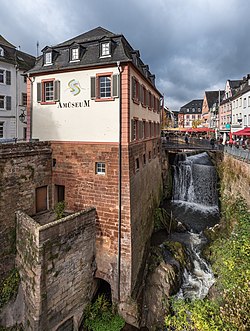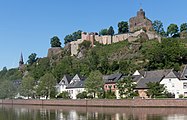|
Saarburg
Saarburg (German pronunciation: [ˈzaːɐ̯bʊʁk], [ˈzaːɐ̯bʊʁç]) is a city of the Trier-Saarburg district, in the state of Rhineland-Palatinate, Germany, on the banks of the river Saar in the hilly country a few kilometers upstream from the Saar's junction with the Moselle. Now known as a tourist attraction, the river Leuk flows into the town centre and makes a spectacular drop of some 60 feet before joining the larger Saar that bisects the town. The waterfall is the result of a 13th-century project to redirect the Leuk through the city centre. Saarburg is the seat of the Verbandsgemeinde ("collective municipality") Saarburg-Kell. The area around Saarburg is noted for the cultivation of Riesling grapes. History The history of the city begins with the construction of the now-ruined castle by Graf Siegfried of Luxembourg in 964. It received its town charter in 1291. The city has a bell foundry, the Glockengießerei Mabilion, which has been in operation since the 1770s, and as of 2003[update] the only one in Germany that produces bronze bells. From 1945 to 1948 Saarburg was occupied by troops from Luxembourg. From 18 July 1946 to 6 June 1947 Onsdorf, in its then municipal boundary, formed part of the Saar Protectorate. French troops complemented the occupation until 1955. Saarburg has a proud history with bells, being the producers of bells for many German cathedrals. Gallery
Twin towns — sister citiesSaarburg is twinned with:
Born in Saarburg
References
External linksWikimedia Commons has media related to Saarburg.
|
||||||||||||||||||||||||||||||||||||||||||||||||||||||









